|
|
|
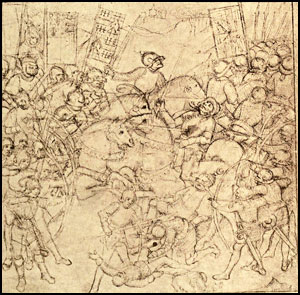

THE STORY OF THE BATTLE OF SHREWSBURY
By Henrietta E. Marshall
Henry IV knew quite well that he was not the real heir to the throne, although he tried to make people believe that he was. The real
heir was Edmund Mortimer, Earl of March.
Richard II was the son of Edward the Black Prince, who was the eldest son of Edward III.
Edmund Mortimer was descended from Lionel of Clarence, who was the third son of Edward III. Henry Bolingbroke [Henry IV]
was descended from John of Gaunt, who was the fourth son of Edward III. So, of course, Edmund Mortimer had a better right to the throne
than Henry Bolingbroke had. But Edmund Mortimer was only a little boy, and, like so many other little princes, he was passed over and forgotten. The people chose
rather to have a strong man who could really rule, than a little boy who could rule only in name. But Henry was afraid of Edmund, and kept him a prisoner in
Windsor Castle, although he was not otherwise unkind to him.
Henry had seized the throne in an unlawful manner, and he found that it was no easy matter to keep it. No sooner was he crowned than plots thickened around him,
and people who had hated Richard were now sorry that they had put Henry on the throne.
The Welsh, who had been conquered by Edward I, had never been content to live under the rule of English kings, and Owen Glendower, a
Welsh nobleman, now rebelled against Henry. He called himself the Prince of Wales, claiming to be descended from Llewellyn, that Welsh prince whom Edward I had
defeated and killed.
Nearly all Wales joined Owen Glendower, and although Henry went against them with a large army, he was not able to subdue them. The Welsh took several of Henry's
nobles prisoner, among them Sir Edmund Mortimer. This Sir Edmund was an uncle of the young Earl of March, whom Henry kept in prison at Windsor. Henry was quite
pleased that Sir Edmund should be a captive, because he was afraid that he might at some time try to put his nephew on the throne.
The Scots had meanwhile also been fighting with the English, and had been defeated by the Earl of Northumberland and his young son,
who was called Harry Hotspur. He was called Hotspur because he was so quick and brave in battle.
Harry Hotspur and his father had taken the Scottish leader, Douglas, prisoner. They expected to get a large ransom from the Scots for him. But Henry said that
Douglas must be given up to him. This made the Percies, as Harry Hotspur and his father were called, very angry. They thought that, as they had taken the Douglas
prisoner, they had a right to the money which would be paid for his release.
The Percies then asked Henry to send money to Owen Glendower to ransom Edmund Mortimer, for Edmund was Harry Hotspur's dear friend. But Henry refused. He did not
wish Edmund to be free, because he was afraid of him. This refusal made the Percies still more angry.
The Percies had helped to put Henry on the throne, but now they became so angry with him that they were sorry that they had done so, and they turned against him.
Instead of giving up the Douglas to Henry, the Percies set him free, on condition that he should help them to fight against the King. They made friends with Owen
Glendower, who set Edmund Mortimer free, and persuaded him also to join them against Henry.
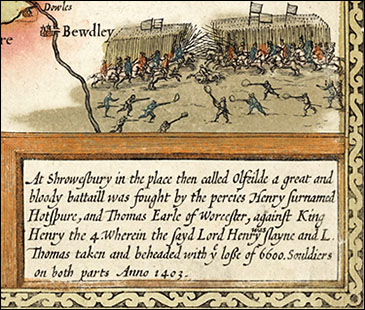
When the King heard of this great rebellion, he marched with a large army to Shrewsbury, and there he defeated the Percies before Owen Glendower could come with
his soldiers to their help.
King Henry had been told that some of the rebel nobles had sworn to kill him, so he went into battle in plain armor, while four or five knights went dressed like the King. These knights were all killed, Douglas himself killing three of them. "I marvel to see so many kings rise thus one after the other," he said. "I have this day slain three."
But the real king was not among them, although he was in the battle fighting bravely.
The Prince of Wales [later Henry V], or Prince Hal, as he was often called, was only a boy, but he did great deeds at this battle, and even when he had been badly wounded, he would not leave the field until victory for his father was sure.
Harry Hotspur was killed, the Douglas taken prisoner, and so with this one battle the rebellion was almost at an end.
Excerpted from:
Marshall, H. E. An Island Story: A History of England, &c..
New York: Frederick A. Stokes Company, 1920. 245-247.
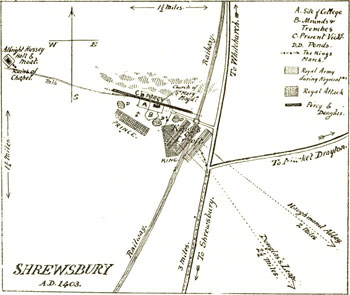
THE BATTLE OF SHREWSBURY
by Sir Charles Oman
...[W]ithin a few months Northumberland was the king's greatest enemy. The breach between the earl and his master started in the winter after Homildon. But the first signs of trouble that gave warning of the rebellion of 1403 came from another quarter. Sir Edmund Mortimer had now been a prisoner in Glendower's migratory camp for six months, and was anxious to ransom himself: but despite his repeated petitions, the king refused either to advance him money or to grant him facilities for raising it himself. Apparently he was glad to keep out of the way one who would be the natural leader of any plot that might be made in favour of the young Earl of March, King Richard's rightful heir: one, too, who was actually nearer to the crown by the strict law of hereditary succession than he was himself.
Whether Mortimer was disloyal at heart before his capture is not known, but in the winter of 1402-3 he made up his mind to throw in his lot with Glendower, and at Christmas married his daughter with great state, and among prophetical hymns of triumph from the bards, who foresaw a notable future for the progeny of such a pair. On December 13 he issued a manifesto to his friends and vassals, informing them that he was leagued with the Prince of Wales [as Glendower called himself] for the purpose of restoring King Richard, if he were still alive, and if he were not, of placing the Earl of March on the throne. Mortimer's treason gave a new aspect to the rebellion; instead of being an anti-English national movement, it might now be considered no more than a branch of a legitimist rising against the usurping house of Lancaster, and many malcontents who would never have joined Owen were ready to adhere to Mortimer. His own vassals in Radnor Forest rose at once, and from thence the movement spread into Brecknock.
The spring and summer of 1403 were a most prosperous time for Glendower: despite the fact that Prince Henry and the Earl of Worcester were collecting an army at Shrewsbury, he resolved to throw himself into South Wales, which had hitherto been undisturbed. On his appearance the country-folk rose to his aid on every side; on July 2 he took Dynevor Castle, on the next day Llandovery, and on the 4th Llandeilo. Two days later he surprised Carmarthen, the largest town of South Wales, slaying fifty of its English inhabitants. But the most striking part of his success was that many strong castles—among them Llanstephan, Dryslwyn, Newcastle Emlyn, Cerig Cennan—were betrayed to him by traitors in the garrisons. Only Pembrokeshire, "little England beyond Wales," remained loyal, and repulsed his marauding bands when they crossed its border. Elsewhere he rode triumphant, and from all the strongholds that still flew St. George's cross urgent messages went to King Henry, bidding him "come riding night and day with a great army" if he would prevent the whole principality from falling into Owen's hands.
But Henry had other business in hand. The Percies had announced their adherence to the cause of Mortimer. For the last six months their discontent had slowly been ripening into treason. Their first grievance had been the king's ingratitude for their good service done at Homildon; he had promised them a great reward, but it took the rather illusory shape of the grant of a palatine earldom across the Scottish border. It was easy to sign away rights over Teviotdale and Nithsdale and Ettrick, but they had to be conquered before the signature had any effect. When Hotspur was sanguine enough to attempt to take possession of the new palatinate, he was repulsed by the first petty castles that he attacked, and returned in wrath.
But the main cause of the breach between the Percies and the king was money—the most fruitful source of dissension between all unscrupulous copartners in an enterprise. Northumberland and his kinsmen, notwithstanding the lavish rewards they had received, still had outstanding claims against Henry, mainly for the pay of the troops which Hotspur had levied against Glendower. The king thought that he had already given them so much, that he need not hurry about discharging new debts. He said that they had from first to last received £60,000 of the public money, and modern research can account for £41,000 actually paid over to them.1
But over and above this quarrel there were other causes of dissension; Mortimer was Hotspur's brother-in-law, and since his lapse into treason the king could not help suspecting his relations. Yet the question of the prisoners of Homildon was the actual topic on which the quarrel broke out. Northumberland had surrendered Murdoch of Fife and several other magnates to the king, but Henry demanded that Douglas and all the other captives of rank should also be made over to him. The earl refused to yield them till all his monetary claims on the crown should be discharged. After much wrangling, Henry ordered great levies to be made, nominally to invade Scotland, really to overawe the Percies by appearing in their country with an army at his back.
This brought matters to a head; before the royal forces had been mobilised the Percies broke into open rebellion. They would brook no refusals from the king they had made, and reckoned that he had outlived his popularity and might be overthrown by a sudden attack. They made elaborate preparations for their enterprise: Hotspur enlisted his captive Douglas and many other Scots in the plot. Communications were opened with Glendower and Mortimer, and it was agreed that they should all unite in proclaiming the Earl of March king, since Richard, as the Percies well knew, was most certainly dead. All the lords of the north were sounded; only Neville of Westmorland returned a wholly uncompromising negative to his old rival's proposals; the Archbishop of York, Richard Scrope, and Skirlaw, Bishop of Durham, lent a favourable ear. Thomas Percy, Earl of Worcester, though one of the king's most favoured servants, consented to join the plot without a moment's hesitation.
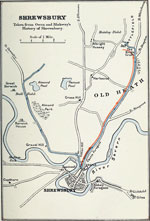
Northumberland was old, and thought fit to hand over the conduct of the campaign to his son Hotspur, for speed and daring were necessary in order to anticipate the king's projected march to the north. Henry Percy's plan was to join the two areas of insurrection by marching to join Glendower on the upper Severn. He resolved to throw himself into Cheshire, which had always been loyal to Richard II, and, after raising its levies, to meet the Welsh at Shrewsbury. The weak point of this project was that Glendower was at the moment out of touch, in the far south of the principality. On July 6, the very day upon which Hotspur started his march, Owen captured Carmarthen. The message calling him back to Shrewsbury arrived too late, for the campaign was short and furious.
Hotspur started from Northumberland with a following of only 160 lances, among whom were Douglas and twenty other Scottish knights. Riding fast, he reached Chester on the 9th, and was there joined by the Earl of Worcester, who had slipped away secretly from Prince Henry's side. The possession of Chester, which links Wales to the north, was a strategic gain of high importance, but there was a weak point in the arrangements of the rebels. Northumberland, who was busy collecting the main body of his retainers in Yorkshire, would not be ready to join his son for some days; Glendower was far away in the south. Till they should come up, Hotspur, with the van of the insurgent host, was left isolated and exposed to King Henry's attack. Though all Cheshire had joined him, he had probably not more than 3,000 or 4,000 men in hand. His fate depended on whether the king would strike before Northumberland and the Welsh arrived. Meanwhile he published a fiery proclamation in which he accused Henry of having violated all the promises that he had made in 1399, of murdering Richard II by slow starvation, of raising illegal loans and taxes, packing his parliaments by intimidation, and ignoring the rights of the Earl of March. All was true enough, but it did not come with a good grace from the mouth of the Percies, the usurper's chief confederates.
The king was at Lichfield on the 11th, when he received the news that Hotspur had seized Chester. His levies were not yet assembled, but he saw the necessity of striking before the rebels had united, and hastily gathered the contingents of the nearer midland shires. His army had grown to some size by the 18th, and he marched on Shrewsbury, rightly judging that this was the point at which Hotspur would strive to join Glendower. Prince Henry was holding the town with a small force which he had collected for an expedition into Wales. On the afternoon of the 20th, the king advancing from Lichfield, and Hotspur marching from Chester, reached Shrewsbury almost simultaneously. The rebels thereupon drew back a short way, seeing that they had arrived too late to secure the town. On the next morning Hotspur drew up his host in an open space called Hately Field, two miles and a half north of Shrewsbury. He occupied a rising ground, partly taken up by cultivated enclosures covered by a dense crop of peas, and approachable only through narrow lanes, which the royalists would have to pass before they could deploy for the fight.
Henry, however, was resolved to push matters to an issue, and marched out of Shrewsbury at dawn as far as the field now known as the King's Croft, where he ranged his army in two divisions, one commanded by himself, the other by his fifteen-year-old son, the Prince of Wales. He decidedly outnumbered the rebels, but they had all the advantage of the ground. Before the battle, several hours were spent in insincere negotiations; the Earl of Worcester took the chief part in the parley, and finally broke it off, taunting his late master with being a king whose word no man would trust. About noon the royalists advanced; they were delayed by the peafields and the narrow lanes, and suffered severely from the archery of the Cheshire men, before they could get to close quarters and make their superior numbers tell.
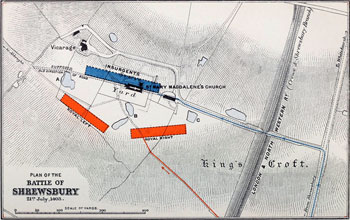
When the king had at last got his bowmen to the front, and the exchange of shafts was growing deadly, Hotspur and Douglas resolved to try the effect of a down-hill charge upon the royal right, where Henry was present in person. Their impetuous rush almost achieved its purpose; the king's banner was beaten down, and the Scottish earl slew with his own hand Sir Thomas Blount, one of two knights who had donned a surcoat with the royal arms, in order to distract attention from their master. But when the impetus of the rebel charge was spent, the royalists enclosed on both sides the wedge of assailants which had penetrated into their line, and at the same time the Prince of Wales on the left outflanked and drove back the right wing of the Percies.
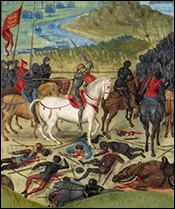 Though in danger of being surrounded, the enemy continued fighting fiercely till their leaders were struck down. Douglas was felled by a wound in the groin, Hotspur killed outright by an unknown hand in the thick of the melee. When the cry "Harry Percy dead" was raised by the king's men, the Cheshire levies broke and dispersed. They were pursued for three miles, and many scores of knights and squires, the flower of the county which had been so loyal to King Richard, were slain or taken, with a great proportion of their archers and billmen.
Though in danger of being surrounded, the enemy continued fighting fiercely till their leaders were struck down. Douglas was felled by a wound in the groin, Hotspur killed outright by an unknown hand in the thick of the melee. When the cry "Harry Percy dead" was raised by the king's men, the Cheshire levies broke and dispersed. They were pursued for three miles, and many scores of knights and squires, the flower of the county which had been so loyal to King Richard, were slain or taken, with a great proportion of their archers and billmen.
The Earl of Worcester, Sir Richard Vernon, and Sir Richard Venables, the three chief prisoners, were beheaded next day; their heads were sent to decorate the spikes on London bridge, while that of Hotspur was reserved for the gate of York. The victory had been a costly one for the king; there fell in his host the Earl of Stafford, Constable of England [Edmund, 5th Earl Stafford], nine knights, and a great multitude of the commons. Some years later Henry erected a church and hospital on the site of the central combat, where 1,600 corpses of both sides were buried in long trenches about the spot where the royal banner had stood.
1. See Sir James Ramsay's calculation in Lancaster and York, i. 57.
Oman, Charles. The History of England.
London: Longmans, Green, and Co., 1906. 178-183.
Other Local Resources:
Books for further study:
Barratt, John. War for the Throne: The Battle of Shrewsbury (1403).
Pen and Sword, 2010.
Boyle, David. Like Leaves Fall in Autumn: Hotspur, Henry IV and
the Battle of Shrewsbury.
Friends of Battlefield Church, 2016.
Priestley, Edgar John. Battle of Shrewsbury, 1403.
Shrewsbury Museums Service, 1979.
Sadler, John. Hotspur: Sir Henry Percy and the Myth of Chivalry.
Pen and Sword, 2022.
Whitewood, Dickon. Shrewsbury 1403: Struggle for a Fragile Crown.
Osprey Publishing, 2017.
The Battle of Shrewsbury on the Web:
 | to Luminarium Encyclopedia |
Site ©1996-2022 Anniina Jokinen. All rights reserved.
This page was created on June 25, 2012. Last updated August 22, 2022.
|
Index of Encyclopedia Entries:
Medieval Cosmology
Prices of Items in Medieval England
Edward II
Isabella of France, Queen of England
Piers Gaveston
Thomas of Brotherton, E. of Norfolk
Edmund of Woodstock, E. of Kent
Thomas, Earl of Lancaster
Henry of Lancaster, Earl of Lancaster
Henry of Grosmont, Duke of Lancaster
Roger Mortimer, Earl of March
Hugh le Despenser the Younger
Bartholomew, Lord Burghersh, elder
Hundred Years' War (1337-1453)
Edward III
Philippa of Hainault, Queen of England
Edward, Black Prince of Wales
John of Eltham, Earl of Cornwall
The Battle of Crécy, 1346
The Siege of Calais, 1346-7
The Battle of Poitiers, 1356
Lionel of Antwerp, Duke of Clarence
John of Gaunt, Duke of Lancaster
Edmund of Langley, Duke of York
Thomas of Woodstock, Gloucester
Richard of York, E. of Cambridge
Richard Fitzalan, 3. Earl of Arundel
Roger Mortimer, 2nd Earl of March
The Good Parliament, 1376
Richard II
The Peasants' Revolt, 1381
Lords Appellant, 1388
Richard Fitzalan, 4. Earl of Arundel
Archbishop Thomas Arundel
Thomas de Beauchamp, E. Warwick
Robert de Vere, Earl of Oxford
Ralph Neville, E. of Westmorland
Thomas Mowbray, Duke of Norfolk
Edmund Mortimer, 3. Earl of March
Roger Mortimer, 4. Earl of March
John Holland, Duke of Exeter
Michael de la Pole, E. Suffolk
Hugh de Stafford, 2. E. Stafford
Henry IV
Edward, Duke of York
Edmund Mortimer, 5. Earl of March
Henry Percy, Earl of Northumberland
Sir Henry Percy, "Harry Hotspur"
Thomas Percy, Earl of Worcester
Owen Glendower
The Battle of Shrewsbury, 1403
Archbishop Richard Scrope
Thomas Mowbray, 3. E. Nottingham
John Mowbray, 2. Duke of Norfolk
Thomas Fitzalan, 5. Earl of Arundel
Henry V
Thomas, Duke of Clarence
John, Duke of Bedford
Humphrey, Duke of Gloucester
John Talbot, Earl of Shrewsbury
Richard, Earl of Cambridge
Henry, Baron Scrope of Masham
William de la Pole, Duke of Suffolk
Thomas Montacute, E. Salisbury
Richard Beauchamp, E. of Warwick
Henry Beauchamp, Duke of Warwick
Thomas Beaufort, Duke of Exeter
Cardinal Henry Beaufort
John Beaufort, Earl of Somerset
Sir John Fastolf
John Holland, 2. Duke of Exeter
Archbishop John Stafford
Archbishop John Kemp
Catherine of Valois
Owen Tudor
John Fitzalan, 7. Earl of Arundel
John, Lord Tiptoft
Charles VII, King of France
Joan of Arc
Louis XI, King of France
Charles the Bold, Duke of Burgundy
The Battle of Agincourt, 1415
The Battle of Castillon, 1453
The Wars of the Roses 1455-1485
Causes of the Wars of the Roses
The House of Lancaster
The House of York
The House of Beaufort
The House of Neville
The First Battle of St. Albans, 1455
The Battle of Blore Heath, 1459
The Rout of Ludford, 1459
The Battle of Northampton, 1460
The Battle of Wakefield, 1460
The Battle of Mortimer's Cross, 1461
The 2nd Battle of St. Albans, 1461
The Battle of Towton, 1461
The Battle of Hedgeley Moor, 1464
The Battle of Hexham, 1464
The Battle of Edgecote, 1469
The Battle of Losecoat Field, 1470
The Battle of Barnet, 1471
The Battle of Tewkesbury, 1471
The Treaty of Pecquigny, 1475
The Battle of Bosworth Field, 1485
The Battle of Stoke Field, 1487
Henry VI
Margaret of Anjou
Richard Plantagenet, Duke of York
Edward IV
Elizabeth Woodville
Richard Woodville, 1. Earl Rivers
Anthony Woodville, 2. Earl Rivers
Jane Shore
Edward V
Richard III
George, Duke of Clarence
Ralph Neville, 2. Earl of Westmorland
Richard Neville, Earl of Salisbury
Richard Neville, Earl of Warwick
Edward Neville, Baron Bergavenny
William Neville, Lord Fauconberg
Robert Neville, Bishop of Salisbury
John Neville, Marquis of Montagu
George Neville, Archbishop of York
John Beaufort, 1. Duke Somerset
Edmund Beaufort, 2. Duke Somerset
Henry Beaufort, 3. Duke of Somerset
Edmund Beaufort, 4. Duke Somerset
Margaret Beaufort
Edmund Tudor, Earl of Richmond
Jasper Tudor, Earl of Pembroke
Humphrey Stafford, D. Buckingham
Henry Stafford, Duke of Buckingham
Humphrey Stafford, E. of Devon
Thomas, Lord Stanley, Earl of Derby
Sir William Stanley
Archbishop Thomas Bourchier
Henry Bourchier, Earl of Essex
John Mowbray, 3. Duke of Norfolk
John Mowbray, 4. Duke of Norfolk
John Howard, Duke of Norfolk
Henry Percy, 2. E. Northumberland
Henry Percy, 3. E. Northumberland
Henry Percy, 4. E. Northumberland
William, Lord Hastings
Henry Holland, Duke of Exeter
William Fitzalan, Earl of Arundel
William Herbert, 1. Earl of Pembroke
John de Vere, 12th Earl of Oxford
John de Vere, 13th Earl of Oxford
Thomas de Clifford, 8. Baron Clifford
John de Clifford, 9. Baron Clifford
John Tiptoft, Earl of Worcester
Thomas Grey, 1. Marquis Dorset
Sir Andrew Trollop
Archbishop John Morton
Edward Plantagenet, E. of Warwick
John Talbot, 2. E. Shrewsbury
John Talbot, 3. E. Shrewsbury
John de la Pole, 2. Duke of Suffolk
John de la Pole, E. of Lincoln
Edmund de la Pole, E. of Suffolk
Richard de la Pole
John Sutton, Baron Dudley
James Butler, 5. Earl of Ormonde
Sir James Tyrell
Edmund Grey, first Earl of Kent
George Grey, 2nd Earl of Kent
John, 5th Baron Scrope of Bolton
James Touchet, 7th Baron Audley
Walter Blount, Lord Mountjoy
Robert Hungerford, Lord Moleyns
Thomas, Lord Scales
John, Lord Lovel and Holand
Francis Lovell, Viscount Lovell
Sir Richard Ratcliffe
William Catesby
Ralph, 4th Lord Cromwell
Jack Cade's Rebellion, 1450
Tudor Period
King Henry VII
Queen Elizabeth of York
Arthur, Prince of Wales
Lambert Simnel
Perkin Warbeck
The Battle of Blackheath, 1497
King Ferdinand II of Aragon
Queen Isabella of Castile
Maximilian I, Holy Roman Emperor
King Henry VIII
Queen Catherine of Aragon
Queen Anne Boleyn
Queen Jane Seymour
Queen Anne of Cleves
Queen Catherine Howard
Queen Katherine Parr
King Edward VI
Queen Mary I
Queen Elizabeth I
Henry Fitzroy, Duke of Richmond
Margaret Tudor, Queen of Scotland
James IV, King of Scotland
The Battle of Flodden Field, 1513
James V, King of Scotland
Mary of Guise, Queen of Scotland
Mary Tudor, Queen of France
Louis XII, King of France
Francis I, King of France
The Battle of the Spurs, 1513
Field of the Cloth of Gold, 1520
Charles V, Holy Roman Emperor
Eustace Chapuys, Imperial Ambassador
The Siege of Boulogne, 1544
Cardinal Thomas Wolsey
Archbishop Thomas Cranmer
Thomas Cromwell, Earl of Essex
Thomas, Lord Audley
Thomas Wriothesley, E. Southampton
Sir Richard Rich
Edward Stafford, D. of Buckingham
Thomas Howard, 2nd Duke of Norfolk
Thomas Howard, 3rd Duke of Norfolk
John Dudley, Duke of Northumberland
Charles Brandon, Duke of Suffolk
Thomas Boleyn, Earl of Wiltshire
George Boleyn, Viscount Rochford
John Russell, Earl of Bedford
Thomas Grey, 2. Marquis of Dorset
Henry Grey, D. of Suffolk
Charles Somerset, Earl of Worcester
George Talbot, 4. E. Shrewsbury
Francis Talbot, 5. E. Shrewsbury
Henry Algernon Percy,
5th Earl of Northumberland
Henry Algernon Percy,
6th Earl of Northumberland
Ralph Neville, 4. E. Westmorland
Henry Neville, 5. E. Westmorland
William Paulet, Marquis of Winchester
Sir Francis Bryan
Sir Nicholas Carew
John de Vere, 15th Earl of Oxford
John de Vere, 16th Earl of Oxford
Thomas Seymour, Lord Admiral
Edward Seymour, Protector Somerset
Margaret Pole, Countess of Salisbury
Henry Pole, Lord Montague
Sir Geoffrey Pole
Thomas Manners, Earl of Rutland
Henry Manners, Earl of Rutland
Henry Bourchier, 2. Earl of Essex
Robert Radcliffe, 1. Earl of Sussex
Henry Radcliffe, 2. Earl of Sussex
George Hastings, Earl of Huntingdon
Henry Courtenay, Marquis of Exeter
George Neville, Baron Bergavenny
Sir Edward Neville
William, Lord Paget
William Sandys, Baron Sandys
William Fitzwilliam, E. Southampton
Sir Anthony Browne
Sir Thomas Wriothesley
Sir William Kingston
George Brooke, Lord Cobham
Sir Richard Southwell
Thomas Fiennes, 9th Lord Dacre
Sir Francis Weston
Henry Norris
Lady Jane Grey
Sir Thomas Arundel
Sir Richard Sackville
Sir William Petre
Sir John Cheke
Walter Haddon, L.L.D
Sir Peter Carew
Sir John Mason
Nicholas Wotton
John Taylor
Sir Thomas Wyatt, the Younger
Cardinal Lorenzo Campeggio
Cardinal Reginald Pole
Stephen Gardiner, Bishop of Winchester
Edmund Bonner, Bishop of London
Nicholas Ridley, Bishop of London
John Hooper, Bishop of Gloucester
John Aylmer, Bishop of London
Thomas Linacre
William Grocyn
Archbishop William Warham
Cuthbert Tunstall, Bishop of Durham
Richard Fox, Bishop of Winchester
Edward Fox, Bishop of Hereford
Pope Julius II
Pope Leo X
Pope Clement VII
Pope Paul III
Pope Pius V
Pico della Mirandola
Desiderius Erasmus
Martin Bucer
Richard Pace
Christopher Saint-German
Thomas Tallis
Elizabeth Barton, the Nun of Kent
Hans Holbein, the Younger
The Sweating Sickness
Dissolution of the Monasteries
Pilgrimage of Grace, 1536
Robert Aske
Anne Askew
Lord Thomas Darcy
Sir Robert Constable
Oath of Supremacy
The Act of Supremacy, 1534
The First Act of Succession, 1534
The Third Act of Succession, 1544
The Ten Articles, 1536
The Six Articles, 1539
The Second Statute of Repeal, 1555
The Act of Supremacy, 1559
Articles Touching Preachers, 1583
Queen Elizabeth I
William Cecil, Lord Burghley
Robert Cecil, 1st Earl of Salisbury
Sir Francis Walsingham
Sir Nicholas Bacon
Sir Thomas Bromley
Robert Dudley, Earl of Leicester
Ambrose Dudley, Earl of Warwick
Henry Carey, Lord Hunsdon
Sir Thomas Egerton, Viscount Brackley
Sir Francis Knollys
Katherine "Kat" Ashley
Lettice Knollys, Countess of Leicester
George Talbot, 6. E. of Shrewsbury
Elizabeth, Countess of Shrewsbury
Gilbert Talbot, 7. E. of Shrewsbury
Sir Henry Sidney
Sir Robert Sidney
Archbishop Matthew Parker
Walter Devereux, 1st Earl of Essex
Robert Devereux, 2nd Earl of Essex
Penelope Devereux, Lady Rich
Sir Christopher Hatton
Edward Courtenay, E. Devonshire
Edward Manners, 3rd Earl of Rutland
Thomas Radcliffe, 3. Earl of Sussex
Henry Radcliffe, 4. Earl of Sussex
Robert Radcliffe, 5. Earl of Sussex
William Parr, Marquis of Northampton
Henry Wriothesley, 2. Southampton
Henry Wriothesley, 3. Southampton
Charles Neville, 6. E. Westmorland
Thomas Percy, 7. E. Northumberland
Henry Percy, 8. E. Northumberland
Henry Percy, 9. E. Nothumberland
William Herbert, 1. Earl of Pembroke
Charles, Lord Howard of Effingham
Thomas Howard, 4th Duke of Norfolk
Henry Howard, 1. Earl of Northampton
Thomas Howard, 1. Earl of Suffolk
Henry Hastings, 3. E. of Huntingdon
Edward Manners, 3rd Earl of Rutland
Roger Manners, 5th Earl of Rutland
Francis Manners, 6th Earl of Rutland
Henry FitzAlan, 12. Earl of Arundel
Thomas, Earl Arundell of Wardour
Edward Somerset, E. of Worcester
William Davison
Sir Walter Mildmay
Sir Ralph Sadler
Sir Amyas Paulet
Gilbert Gifford
Anthony Browne, Viscount Montague
François, Duke of Alençon & Anjou
Mary, Queen of Scots
Henry Stuart, Lord Darnley
James Hepburn, Earl of Bothwell
Anthony Babington and the Babington Plot
John Knox
Philip II of Spain
The Spanish Armada, 1588
Sir Francis Drake
Sir John Hawkins
William Camden
Archbishop Whitgift
Martin Marprelate Controversy
John Penry (Martin Marprelate)
Richard Bancroft, Archbishop of Canterbury
John Dee, Alchemist
Philip Henslowe
Edward Alleyn
The Blackfriars Theatre
The Fortune Theatre
The Rose Theatre
The Swan Theatre
Children's Companies
The Admiral's Men
The Lord Chamberlain's Men
Citizen Comedy
The Isle of Dogs, 1597
Common Law
Court of Common Pleas
Court of King's Bench
Court of Star Chamber
Council of the North
Fleet Prison
Assize
Attainder
First Fruits & Tenths
Livery and Maintenance
Oyer and terminer
Praemunire
The Stuarts
King James I of England
Anne of Denmark
Henry, Prince of Wales
The Gunpowder Plot, 1605
George Villiers, 1st Duke of Buckingham
Robert Carr, Earl of Somerset
Arabella Stuart, Lady Lennox
William Alabaster
Bishop Hall
Bishop Thomas Morton
Archbishop William Laud
John Selden
Lucy Harington, Countess of Bedford
Henry Lawes
King Charles I
Queen Henrietta Maria
Long Parliament
Rump Parliament
Kentish Petition, 1642
Thomas Wentworth, Earl of Strafford
John Digby, Earl of Bristol
George Digby, 2nd Earl of Bristol
Thomas Fairfax, 3rd Lord Fairfax
Robert Devereux, 3rd E. of Essex
Robert Sidney, 2. E. of Leicester
Algernon Percy, E. of Northumberland
Henry Montagu, Earl of Manchester
Edward Montagu, 2. Earl of Manchester
The Restoration
King Charles II
King James II
Test Acts
Greenwich Palace
Hatfield House
Richmond Palace
Windsor Palace
Woodstock Manor
The Cinque Ports
Mermaid Tavern
Malmsey Wine
Great Fire of London, 1666
Merchant Taylors' School
Westminster School
The Sanctuary at Westminster
"Sanctuary"
Images:
Chart of the English Succession from William I through Henry VII
Medieval English Drama
London c1480, MS Royal 16
London, 1510, the earliest view in print
Map of England from Saxton's Descriptio Angliae, 1579
London in late 16th century
Location Map of Elizabethan London
Plan of the Bankside, Southwark, in Shakespeare's time
Detail of Norden's Map of the Bankside, 1593
Bull and Bear Baiting Rings from the Agas Map (1569-1590, pub. 1631)
Sketch of the Swan Theatre, c. 1596
Westminster in the Seventeenth Century, by Hollar
Visscher's View of London, 1616
Larger Visscher's View in Sections
c. 1690. View of London Churches, after the Great Fire
The Yard of the Tabard Inn from Thornbury, Old and New London
|
|